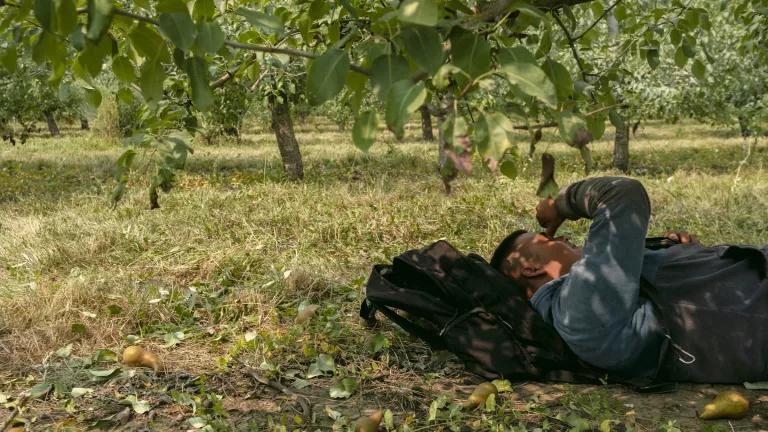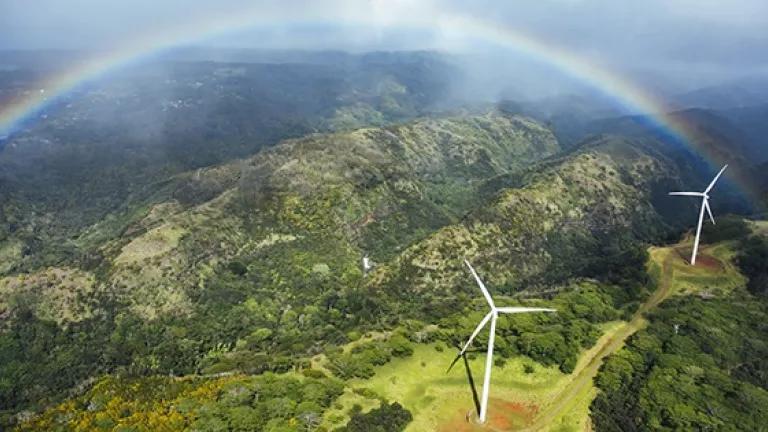Heat Stress Is Killing Workers. States Can Protect Them.
As climate change continues to progress, workers don’t have years to wait for federal rules. So local advocates are helping states create their own.

A worker rests in the shade of a pear tree during the final break of a work day in Phoenix, Oregon.
The day Sebastian Francisco Perez died, temperatures reached 104 degrees Fahrenheit. The 38-year-old collapsed while working in the fields at a tree-and-shrub nursery in St. Paul, Oregon, a small town about 30 miles south of Portland. Perez was one of more than 100 people in the state who died from heat-related causes during a record-shattering heat wave that blanketed the Pacific Northwest for more than a week in summer 2021.
Nearly a year after Governor Kate Brown enacted emergency protections in response to the event, Oregon has adopted permanent ones for both outdoor and indoor workers. They are the strongest heat protections in the nation. Among other things, the new regulations require access to shade and cool water and guarantee paid breaks. They also establish a buddy system for workers—a measure that could have saved the life of Perez, who was alone when his coworkers found him unresponsive.
In the absence of federal heat safeguards and as climate change fuels hotter, longer, and more frequent heat waves, the responsibility falls to the states to protect their workers. California started that effort in 2006. Minnesota followed in 2014. Since then, only Washington, Colorado, and now Oregon, have followed suit with their own standards, but a handful of other states are currently drafting their own rules or have introduced heat safety legislation. A new map tracks all of these state-led efforts across the United States.
As for action on the federal level, President Joe Biden directed the Occupational Safety and Health Administration (OSHA) last September to begin working on a national standard. While promising, rulemaking by OSHA takes more than seven years, on average. This makes swift action by the states all the more urgent, says Juanita Constible, a climate and health advocate at NRDC. “By moving faster, states not only help protect workers sooner, but they can actually help OSHA go in the right direction.”
The extreme dangers of extreme heat
Exposure to extreme heat conditions, both in short stints and over longer periods, can cause a range of issues, including rashes, exhaustion, dehydration, and heatstroke, which can lead to cardiovascular, respiratory, or kidney failure. The youngest and oldest among us and those with underlying conditions, such as asthma or high blood pressure, are especially vulnerable. A recent study also linked extreme heat to an increase in several mental health conditions.
According to the U.S. Bureau of Labor Statistics, between 1992 and 2019, extreme heat killed more than 900 workers and sickened tens of thousands more. Those numbers, however, are likely an undercount due to the lack of reporting by negligent employers or by workers who are worried about retaliation or deportation. In addition to the physical implications, time off from a job due to illness can lead to missed wages or the loss of a job altogether.
Heat impacts workers across a wide range of sectors. While outdoor workers in agriculture and construction experience the highest rates of heat-related illness, indoor workers in warehouses, restaurants, schools, and other poorly ventilated or inadequately cooled spaces also face disproportionate health risks on the job. Because workers of color are overrepresented across these industries, they suffer from heat-related illness and fatalities more frequently than white workers. For example, a 2021 investigation by National Public Radio and Columbia Journalism Investigations found that Hispanics represented a third of heat deaths occurring at work since 2010, despite consisting of just 17 percent of the U.S. workforce.
States are setting a precedent
Under the General Duty Clause of the Occupational Safety and Health Act of 1970, employers must protect workers from “hazards that are causing or are likely to cause death or serious physical harm,” and provide basic necessities of rest, water, and shade. Unfortunately, a lack of heat-specific details in the clause, such as temperature triggers or even any mention of heat as a hazard, limits the act’s practicality. It’s also proven difficult to enforce.
Discussions of a heat stress standard in California began in 1984, in response to a petition by the Los Angeles Librarians’ Guild describing how librarians were suffering from heat illness due to the lack of air-conditioning. But it wasn’t until 2005, prompted by several heat-related illnesses and deaths among agricultural and construction workers, that the state got serious about protecting workers from the heat. Within a year, the California Division of Occupational Safety and Health (Cal/OSHA) published permanent rules, which have since become a model for other states. Even so, the California workplace heat standard leaves room for improvement. A new report by NRDC offers recommendations to that end, including specific protections for indoor workers, reduced production quotas during periods of high heat, and increased funding for bilingual OSHA inspectors and heat stress training materials in different languages.
California paved the way for the set of even stronger heat standards now in place in Oregon. Jamie Pang of the Oregon Environmental Council hopes that by setting a high bar, including temperature triggers of 80 degrees and paid breaks, her state’s regulations can become an even better model for others (including OSHA) to follow. But for that to happen, she cautions that Oregon must follow through with strong enforcement—and defense—of its standards.
Back in California, advocates like Nancy Zuniga, who manages the worker health program at the Institute of Popular Education of Southern California (IDEPSCA), are focused on making sure day laborers and household workers, who are currently excluded from California’s workplace heat standards, also get the protections they need. “The basic rights that workers have during extreme heat—breaks, shade, water—are unfortunately not readily available for day laborers,” she says. “So we try to educate workers to fend for these things for themselves: to make sure that they take their water, to make sure that they are checking on their buddy.” IDEPSCA also distributes masks and other personal protective equipment—for instance, against COVID-19 and wildfire smoke—at its centers in Los Angeles. “Between our advocacy and education, we’re making sure that when that exclusion hopefully gets removed, workers will already know what their rights are.”

An orchard worker unloads a bag of pears in Hood River, Oregon.
The challenges ahead
Despite progress, securing heat protections isn’t easy. For instance, Oregon’s new heat rules—in addition to the ones protecting workers from wildfire smoke that were published at the same time—are currently facing legal challenges from the timber industry.
Constible says we should expect such pushback across the country. “Every rule that is instituted will face legal challenges,” she says. “We need to find the compromise points that will get industry leaders onboard enough that they will actually be willing to implement safeguards rather than fighting them until the whole world burns up.”
The political climates in many states, particularly those in the hot, humid Southeast, are unwelcoming to such protections. This is the case in Florida, where Oscar Londoño, co-executive director of WeCount!, advocates for protections for low-wage immigrant workers. For three consecutive years, the organization drafted and got legislation introduced in Tallahassee. Yet, despite bipartisan support in Miami-Dade County, where WeCount! is based, the bills never moved forward. So Londoño and WeCount!’s workers have shifted their strategy.
“For us, the question now is, can we pass something locally, in Florida’s largest county of Miami-Dade, that would cover anywhere between 100,000 to 300,000 outdoor workers,” says Londoño. WeCount! is in the process of negotiating when such legislation might be introduced, and Londoño plans to help others replicate more local standards to protect as many workers as quickly as possible. “This is not just about Miami-Dade County,” he says. “It’s a model for the rest of the state, and others, where state legislation is impossible.”

Heat protections for workers, by workers
In formulating heat stress standards, on any level, it’s critical that workers themselves be involved from the start. That helps make sure that any new rules “are actually practical and not going to make the workers’ lives even worse,” Constible says. “There’s research, and then there’s the lived reality of what workers are dealing with on a day-to-day basis—and those may not always align.”
Londoño agrees, and says passing a new policy or a new law isn't enough. We need to make sure that workers are the ones identifying the effective strategies and that their expertise informs the process, he notes. And we need to do it soon. “In humid, high-temperature regions like Florida, we don't have time to wait for OSHA,” he says.
Another concern is that states will base their rules on our current climate, or even the climate we had a decade ago. “Rulemaking is a slow process, and amending a rule is not much faster. So it’s important to get it right on the front end rather than just reacting to the next deadly heat wave,” says Constible. “We can't keep preparing for the disasters of the past.”
This story has been updated with a link to NRDC’s report, “Feeling the Heat: How California’s Workplace Heat Standards Can Inform Stronger Protections Nationwide.”
This NRDC.org story is available for online republication by news media outlets or nonprofits under these conditions: The writer(s) must be credited with a byline; you must note prominently that the story was originally published by NRDC.org and link to the original; the story cannot be edited (beyond simple things such as grammar); you can’t resell the story in any form or grant republishing rights to other outlets; you can’t republish our material wholesale or automatically—you need to select stories individually; you can’t republish the photos or graphics on our site without specific permission; you should drop us a note to let us know when you’ve used one of our stories.
We need climate action to be a top priority in Washington.
Tell President Biden and Congress to slash climate pollution and reduce our dependence on fossil fuels.

Urge President Biden and Congress to make equitable climate action a top priority
2023 was the hottest year on record, underscoring the urgency of shifting to clean energy and curbing the carbon pollution that is driving the climate crisis. President Biden and Congress have the tools to get the job done.

Mutual Aid and Disaster Justice: “We Keep Us Safe”
When Customers and Investors Demand Corporate Sustainability
How to Make an Effective Public Comment